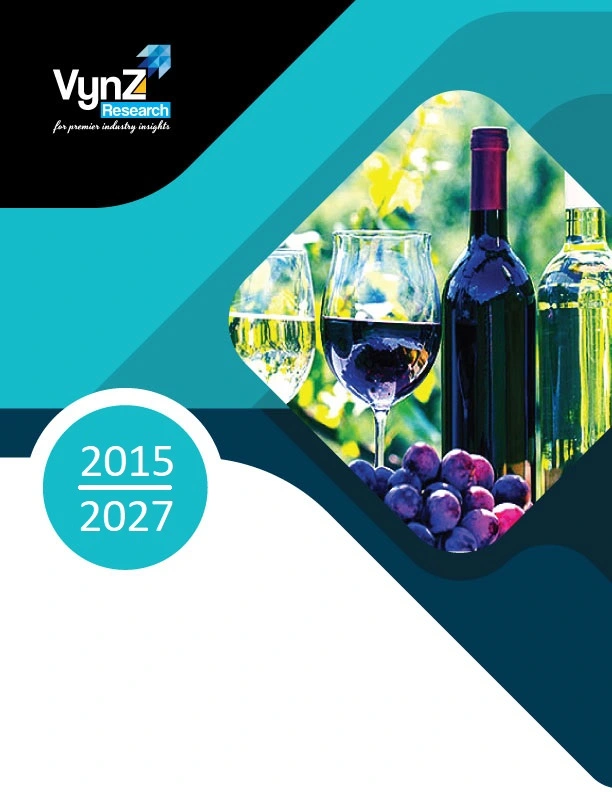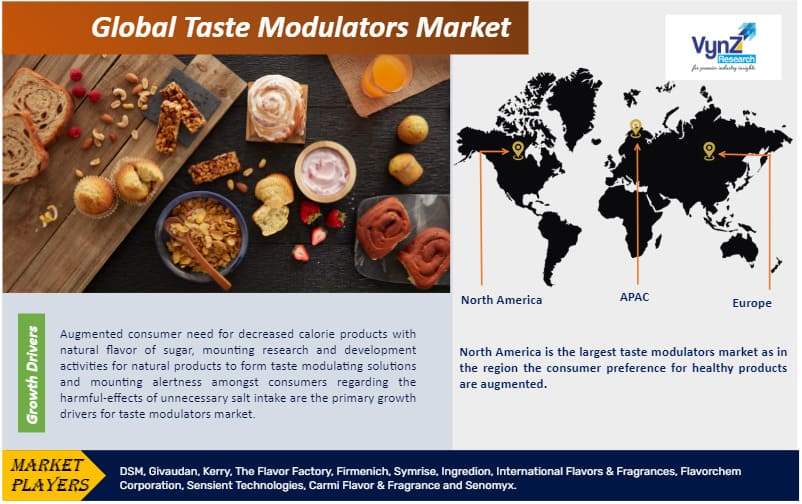| Status : Upcoming | Report Code : VRFB11008 | Industry : Food & Beverage | Available Format :

|

Global Taste Modulators Market – Analysis and Forecast (2025-2030)
Industry Insights by Application (Beverages and Food) and by Type (Fat Modulators, Sweet Modulators and Salt Modulators)
Industry Overview
Taste modulators alter the taste and maintain the decrease of calories in the drink and food to meet the consumer demand for healthy products. It is consumed in products such as beer, sports drinks, energy drinks, and whiskey. Augmented consumer need for decreased calorie products and widespread research on positive allosteric modulators are the major factors driving the growth of the Taste Modulators Market. Different types supported the taste modulators' market size. The market has witnessed a high command for sweet modulators in the coming years due to the mounting alertness about several diseases such as obesity and diabetes.

Taste Modulators Market Segmentation
Insight by Application
Based on application, the taste modulators market is subdivided into beverages and food. Among both applications, the beverages segment accounted for the largest share and is expected to grow at the fastest rate in the market due to an upsurge in the utilization of energy & sports drinks.
The food segment is further subdivided into bakery products, confectionery products, meat products, dairy products, snacks & savory products, and others. In addition, the beverages segment is further subdivided into non-alcoholic beverages and alcoholic beverages. The non-alcoholic segment accounted for the largest share of the market.
Insight by Type
Based on type, the market is subdivided into fat modulators, sweet modulators, and salt modulators. Among the types, the sweet modulators segment accounted for the largest share and is expected to grow at the fastest rate in the market due to the mounting alertness amongst consumers about several diseases such as obesity and diabetes, improved taste, and nourishing advantages. Sweet modulators are consumed in several food applications such as bakery products, snacks & savory products, and confectionery products
Global Taste Modulators Market Report Coverage
|
Report Metric |
Details |
|
Historical Period |
2018 - 2023 |
|
Base Year Considered |
2024 |
|
Forecast Period |
2025 - 2030 |
|
Market Size in 2024 |
U.S.D. XX Billion |
|
Revenue Forecast in 2030 |
U.S.D. XX Billion |
|
Growth Rate |
XX% |
|
Segments Covered in the Report |
By Application and By Type |
|
Report Scope |
Market Trends, Drivers, and Restraints; Revenue Estimation and Forecast; Segmentation Analysis; Impact of COVID-19; Companies’ Strategic Developments; Market Share Analysis of Key Players; Company Profiling |
|
Regions Covered in the Report |
North America, Europe, Asia-Pacific, Middle East, and Rest of the World |
Industry Dynamics
Taste Modulators Industry Trends
Research on several flavor extraction methodologies by the manufacturers, substitution of sugars with stevia, and persuading the food industry to utilize taste modulation solutions are the trends in the taste modulation market.
Taste Modulators Market Growth Drivers
Augmented consumer need for decreased calorie products with the natural flavor of sugar, mounting research and development activities for natural products to form taste-modulating solutions, and mounting alertness amongst consumers regarding the harmful effects of unnecessary salt intake are the primary growth drivers for the taste-modulators market. The sweet modulators offer a sugary taste with no calories to food products. It is consumed by manufacturers to reestablish the sweet taste.
Widespread research on positive allosteric modulators (PAM) and a mounting number of people suffering from diabetes and obesity are also facilitating the growth of the taste modulators market. For instance, according to World Health Organization (WHO), globally the number of people with diabetes has risen from 108 million in 1980 to 422 million in 2014. In addition, according to the International Diabetes Federation (IDF) in 2017, globally approximately 425 million adults were suffering from diabetes, and are expected to reach 629 million in 2045.
Taste Modulators Market Challenges
Strict regulations and international norms for sweet and salt-decreasing ingredients and uncertainty about the health effects of sugar substitutes are the major challenges to the growth of the taste modulators market.
Taste Modulators Industry Ecosystem
Globally, the manufacturing companies trying to enter the taste modulators market must maintain stringent regulatory standards. This offers an edge to the established players in the industry competition. Moreover, the high level of capital requirement also poses a major barrier to the entry of new players.
Taste Modulators Market Geographic Overview
Geographically, North America is the largest taste modulators market as in the region the consumer preference for healthy products are augmented. Mounting the number of people suffering from diabetes and obesity, and an upsurge in the acceptance of low-fat & low-calorie content foods have boosted the demand for taste modulators market in the North American region. For instance, according to the Centers for Disease Control and Prevention (CDC), in 2015 approximately 23.1 million people in the U.S. had diabetes.
Asia-Pacific is observed to witness the fastest growth in the market, due to its large population base. In addition, a mounting number of people suffering from diabetes and obesity, and an upsurge in alertness about healthy & nutritional food products are also creating a positive impact on the taste modulators market growth in the region.
Taste Modulators Market Competitive Insight
Key players in the taste modulators market are catering to the demand by investing in new product launches in their product portfolios across the globe. In July 2018, DSM introduced AVANSYA Reb M, a new-generation sweetner, that allows advanced sugar reduction in a variety of food and beverages.
In addition, in July 2018, Sensient Technologies acquired Vancouver to meet customer needs for pure ingredients in nutraceuticals, food and beverage, and personal care products. DSM, Givaudan, Kerry, The Flavor Factory, Firmenich, Symrise, Ingredion, International Flavors & Fragrances, Flavorchem Corporation, Sensient Technologies, Carmi Flavor & Fragrance, and Senomyx are the key players offering taste modulators.
Frequently Asked Questions
Purchase Options
Latest Report
Research Methodology
- Desk Research / Pilot Interviews
- Build Market Size Model
- Research and Analysis
- Final Deliverabvle
Connect With Our Sales Team
- Toll-Free: 1 888 253 3960
- Phone: +91 9960 288 381
- Email: enquiry@vynzresearch.com
Taste Modulators Market
